

TOA's Legacy of Manufacturing
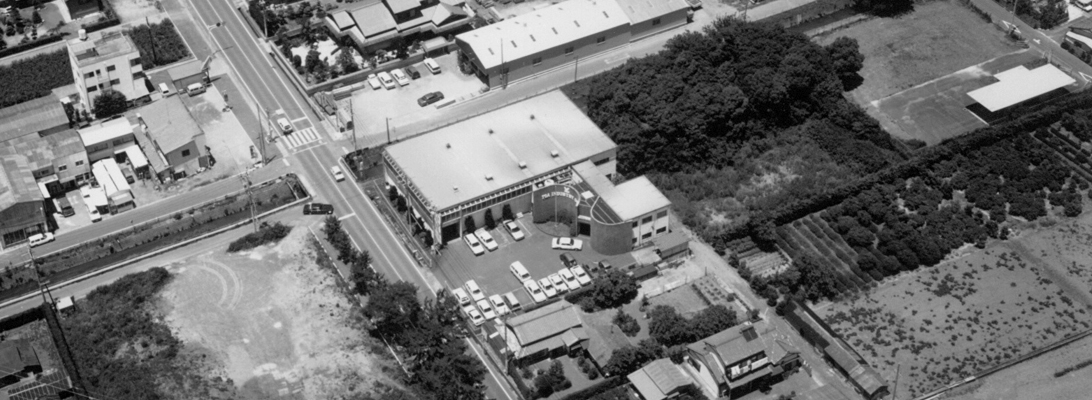
Technological roots of Toa Industry can be
traced back to the two wheel motorcycle manufacturer, Marusho Motor Co.,
Ltd., which was second in starting the manufacture of motorcycles in
postwar Hamamatsu city.
Through creative manufacturing of Marusho Motors as represented by its iconic "Lilac" mtoorcycle, our founder, Yoshio Ukei, learned the "technology and the spirit of challenge".
And in the postwar Hamamatsu where numerous manufacturers large and small were starting their manufacturing, Ukei too founded Toa Industry dreaming of one day becoming an own brand manufacture company.
Hamamatsu people are known for their Yaramaika (Let's Do It) spirit. Yoshio Ukei too was a man of creativity and challenge, who would say "let's do it anyway".
The dumpling making machines of Toa Industry has not only replicated the speciality taste of customers' dumplings, but also inherited that spirit of "Yaramaika" that has supported the manufacturing of Japan.
Through creative manufacturing of Marusho Motors as represented by its iconic "Lilac" mtoorcycle, our founder, Yoshio Ukei, learned the "technology and the spirit of challenge".
And in the postwar Hamamatsu where numerous manufacturers large and small were starting their manufacturing, Ukei too founded Toa Industry dreaming of one day becoming an own brand manufacture company.
Hamamatsu people are known for their Yaramaika (Let's Do It) spirit. Yoshio Ukei too was a man of creativity and challenge, who would say "let's do it anyway".
The dumpling making machines of Toa Industry has not only replicated the speciality taste of customers' dumplings, but also inherited that spirit of "Yaramaika" that has supported the manufacturing of Japan.
1950s
Yoshio Ukei, the founder
Joined Marusho Motor Co., Ltd.
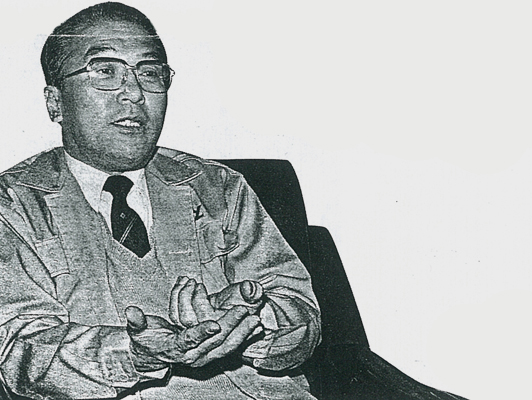
Yoshio Ukei, the founder of Toa
Industry. Immediately after graduating from high school, he joined
Marusho Motor Co., Ltd. Mr. Ito, the coroporate president of Marusho
Motor was a junior of Mr. Soichiro Honda and was active in "Art Shokai
Co., Ltd." and "Tokai Seiki Co., Ltd." as well. Ukei inherited their
spirit of manufacturing.
In 1951, our founder, Yoshio Ukei joined
Marusho Motor Co., Ltd. They were a motorbike manufacturer that
manufactured the famous "lilac" which is known for its innovative
designs such as the usage of shaft drive. Ukei worked for and
experienced various departments ranging from design to construction,
purchase to planning. The process of "manufacturing from zero" that he
learned at this time became the roots of originality of Toa Industry
which is continuing to this day.
1960s
From a subcontract factory
To become a manufacturer.
On August 1, 1963, Ukei founded "Toa Industry"
based on the experience accumulated in Marusho Motor. It was a start
with just 6 people. As a subcontractor of an automobile company, they
produced molds for car parts, and the business grew steadily, riding on
the wave of high economic growth and motorization. In 1966, he
incorporated Toa Industry Co., Ltd. Although there was an option to
expand the scale as an automobile parts manufacturing company, Ukei
could not forego the dream of becoming, not a sub-contractor, but a
"manufacturer of his own product", and so he continued to invest in
equipments and research of his original product.
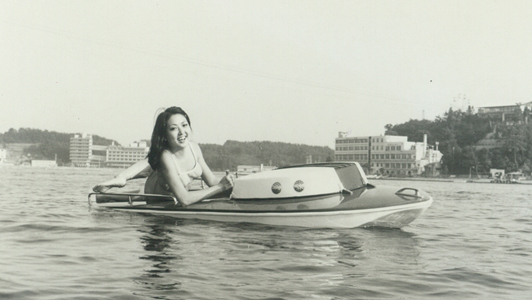
One
of the traces of Toa Industry's efforts at becoming a vehicle
manufacturer is this pleasure boat. Unfortunately, it did not reach the
retail stage, but there is an advert with the name "water jet", showing
that it was at its final stage of release.
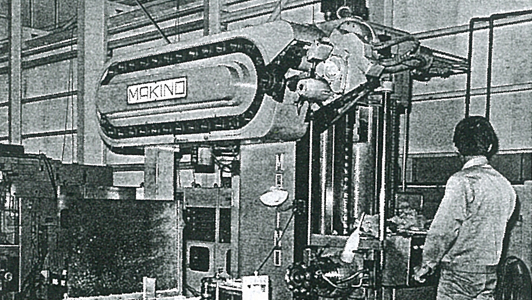
NC
milling machine that was introduced in 1964. For Toa Industry then,
this was an investment beyond its means, and some were worried of it
endangering the company management. However, this machine whose use was
unsure in the beginning, was in a few years time running in full
operation.
1970s
The research and development
of automated gyoza making machine begin.
Although it was natural for Ukei and Toa Industry
to find a way to success with motor vehicle development given his
experiences in the field, it was a gyoza(dumpling)-making machine he
encountered on his visit to a certain food company that became a turning
point. This gyoza(dumpling)-making machine was a latest model of its
kind, but from the technical standpoint of automotive engineering, it
seemed there was a room for many improvements. Moreover, the work of
squeezing the dumpling skin and cutting it out with the mold was,
essentially, the same as the pressing work done with the mold in
automotive industry.
"I can make it better", Ukei was convinced, and alongside his main business, he diligently continued his research, and finally completed the first machine at the end of 1975. The large-sized automated gyoza making machine named "T-8" was the first of the own brand product that was sold.
"I can make it better", Ukei was convinced, and alongside his main business, he diligently continued his research, and finally completed the first machine at the end of 1975. The large-sized automated gyoza making machine named "T-8" was the first of the own brand product that was sold.
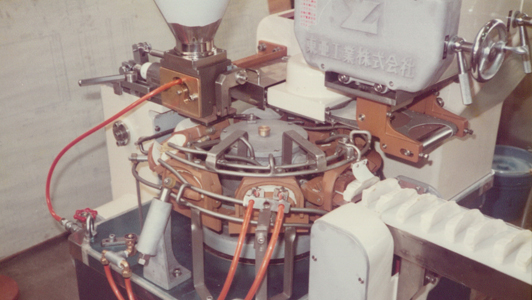
On
December 19, 1975, Toa Industry's first complete machine was released.
With 8 trays, it could produce 4,800 dumplings per hour. Unlike the
existing gyoza(dumpling)-making machines made by other companies, it was
characterized by completely automating the loading of the fillings, and
gained attention with its high production efficiency. The photograph is
a prototype.
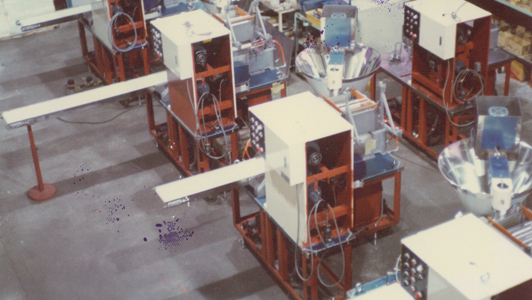
Head
office factory at the time. Many large gyoza(dumpling)-making machines
are lined up tightly. At the time, the main clients were the major food
corporations, and the machine was to make dumplings for supermarket
products and frozen foods. The gyoza dumplings that were previously time
and effort consuming side-dish, became a familiar dish that was easily
purchased and served at dinner by busy housewives.

There
were many twists and turns before completing the pallet mechanism which
continues to the present. One such is this photo Here, too much
emphasis was placed on reproducing the hand movement of the person, that
the wrapping mechanism became too complicated, and this model was never
adopted.
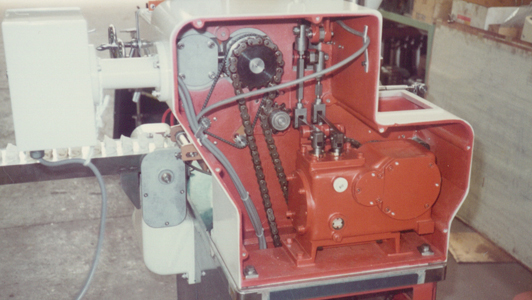
This
photo illustrates well that the manufacturing roots of Toa Industry are
in cars and motorcycles. Using the technology proven in automobile
engines and drive systems of motorcycles, Toa products possessed high
durability and reliability right from the initial model.
1980s
Arrival of the compact gyoza(dumpling)-making machine
that would replicate the tastes of restaurants
Approximately 200 units were released to the
world within 5 years of the appearance of the first machine "T-8". By
gathering feedback from customers, next model "T-16" was developed with
various improvements such as the changes in the fillings loading system,
receiving high acclaim even from the well-established traditional
restaurants for replicating the taste and the texture, and became a big
hit. Improvements were continued to be made, and the successor machine
"TX-16-DL" realized high maitainability and more than twice the production
capacity of the initial machine, and continues to be the main machine of
Toa Industry to this day.
On the other hand, the machine whose focus was on the "wrapping technique" of Toa Industry which would replicate various sizes and shapes of dumplings, was the the compact gyoza(dumpling)-making machine series which first appeared in 1988. The gyoza dumpling that requires delicate operation by the human hand at various stages of its production, is different in taste, shape and texture for each restaurant and shop. The compact machine was of a size that was possible to be set up in a small private shops, and yet it would faithfully replicate the taste and texture of the restaurant. It did not take long for this machine to be accepted by restaurants and grocery stores all over Japan, and soon became the main product of our comnpany.
On the other hand, the machine whose focus was on the "wrapping technique" of Toa Industry which would replicate various sizes and shapes of dumplings, was the the compact gyoza(dumpling)-making machine series which first appeared in 1988. The gyoza dumpling that requires delicate operation by the human hand at various stages of its production, is different in taste, shape and texture for each restaurant and shop. The compact machine was of a size that was possible to be set up in a small private shops, and yet it would faithfully replicate the taste and texture of the restaurant. It did not take long for this machine to be accepted by restaurants and grocery stores all over Japan, and soon became the main product of our comnpany.
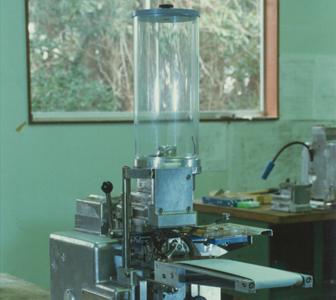
The
compact gyoza(dumpling)-making machine gained great support from
restaurants that have kept their own taste with few personnel. Many
prototypes were created to replicate the individuality of different
dumplings for each shop while bringing out the merits of automation.
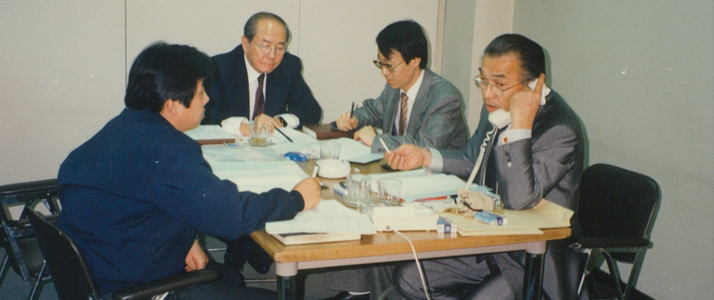
Sales
department in the late 1980s. With the hit of the compact
gyoza(dumpling)-making machine, the sales and service network for
individual shops all over Japan was expanded. In addition to selling
machinery, an affiliated company was set up to provide maintenance and
repair services, thereby improving service quality.
1990~
From gyoza of Japan
to gyoza of the world.
In the 1990s, exports began full-fledged to South
Korea and Taiwan from where inquiries were coming since the late '80s.
The pan fried gyoza dumplings went overseas as one of the "flavours of
Japan" along with the gyoza(dumpling)-making machines of Toa Industry.
Also, there were restaurants that added gyoza dumpling to their menu by
installing our machine, and food manufacturers that began the production
and sales of dumplings as a new business with the implementation of our
machine. As a result, Toa Industry took on the role of supporting such
setting up of new gyoza dumpling business. This is the roots of the
current "Support of Gyoza Restaurant Startups".
With the manufacturing spirit nurtured over the years at its core, Toa Industry will continue the challenge of spreading to the world the appeal of dumplings, which has become a food culture of Japan.
With the manufacturing spirit nurtured over the years at its core, Toa Industry will continue the challenge of spreading to the world the appeal of dumplings, which has become a food culture of Japan.
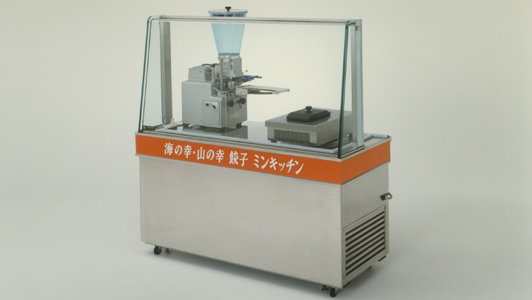
The
"Min kitchen", a movable stall with a compact gyoza(dumpling)-making
machine attached, to perform demonstrations of the actual production at
supermarkets etc. Although this was only a reference exhibit at a food
event, it led to a new approach not only to manufacture machines but
also to propose new businesses using dumplings.
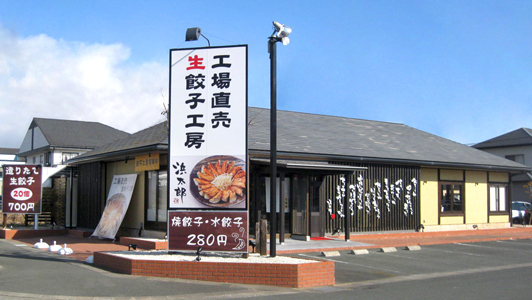
In
2010, by practicing "business proposals using dumplings" ourselves, we
started the business setup support service full scale. As a one and only
company that can support the creation of a popular restaurant from
scratch, Toa Industry is a pioneer of a new road.

